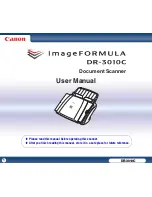
COPYRIGHT © 2006 CANON ELECTRONICS INC. CANON DR-1210C FIRST EDITION FEB. 2006
2-5
CHAPTER 2 FUNCTION & OPERATION
The figure below shows a sectional view
of the image reading section.
Document
Mirror
Reading glass
Lens
CCD
Shading sheet
Fluorescent lamp
Figure 2-202
The light emitted by the light source
(fluorescent lamp) passes through the
reading glass, is reflected by the document,
then goes into the reading unit. In the
reading unit, the incident light is reflected by
five mirrors, passes through a lens and
reaches the CCD. The CCD PCB converts
the data to analog signals, which are output
to the main PCB.
As the light source, the machine uses a
cold cathode fluorescent lamp (CCFL),
which is generally called a fluorescent lamp.
The CCD is a three-color (R/G/B), three-line
sensor having a picture element density of
600 dpi and an effective picture element of
5340 pixels. It is noticeable that the CCD
can make analog grayscale outputs besides
the R/G/B outputs.
The shading sheet is placed between
the reading glass and the flatbed cover, so
that it is aligned to the home position of the
reading unit. The reading unit has a sensor
to detect the home position.
After such events as the machine power
is turned on, the driver setting is changed
and an error occurs, the machine reads the
shading sheet data and calculates the cor-
rected values prior to scanning.
In addition, the machine reads the
shading sheet data prior to each scanning
operation to ensure the light intensity from
the fluorescent lamp. In case of low or un-
stable light intensity from the fluorescent
lamp, which may be encountered after the
machine power is turned on and the ma-
chine is resumed from the power saving
mode, the machine goes into the warming
up state, showing “Warming up” on the dis-
play, and does not carry out scanning before
resuming the normal condition.
















































